Nestled on the west coast of Africa, Gabon is an eco-tourist’s paradise. It boasts rich biodiversity, diverse ecosystems, and a network of protected areas, making it an unparalleled destination to experience the wonders of African wildlife and its 13 national parks.
Gabon’s forests (which cover more than 80%) are among the richest in Africa, with an estimated 8,000 plant species, more than all of West Africa’s forests combined. The country’s fauna is equally impressive, with over 190 mammal species, including at least 20 species of monkeys, more than 600 species of birds, 70 species of reptiles, and 100 species of amphibians. Gabon is home to about 35,000 gorillas and 64,000 chimpanzees, and its elephant population numbers between 60,000 and 74,000 individuals.
Gabon’s people have a deep connection to the natural world. They have lived in harmony with the forest for centuries, and they have a deep understanding of the delicate balance of ecosystems. Despite its remarkable biodiversity, Gabon’s protected areas face challenges. Some important ecosystems remain inadequately protected, and many protected areas are understaffed and underfunded.
Gabon’s government is committed to sustainable development, and it is working to preserve the country’s natural resources for future generations.
Table of Contents
National Parks in Gabon
Gabon has 13 national parks, established in 2002 by former President Omar Bongo through Gabon’s National Agency for National Parks (ANPN), covering 10% of the country. Each park boasts unique attractions, such as Akanda’s largest concentration of West African hippos, Birougou’s diverse primate population, Ivindo’s stunning waterfalls and wildlife, Lopé’s mix of savannas, forests, and wetlands with elephants, buffaloes, and hippos, Mayumba’s beautiful beaches and wildlife, Minkébé’s world’s largest gorilla population, Monts de Cristal’s diverse birdlife, Moukalaba-Douala’s variety of animals, Nkélé-Ékok’s diverse flora and fauna, Ogooué-Léfini’s fish and wildlife, Pongara’s plant and animal diversity, and Waka’s rich ecosystem with elephants, buffaloes, and hippos.
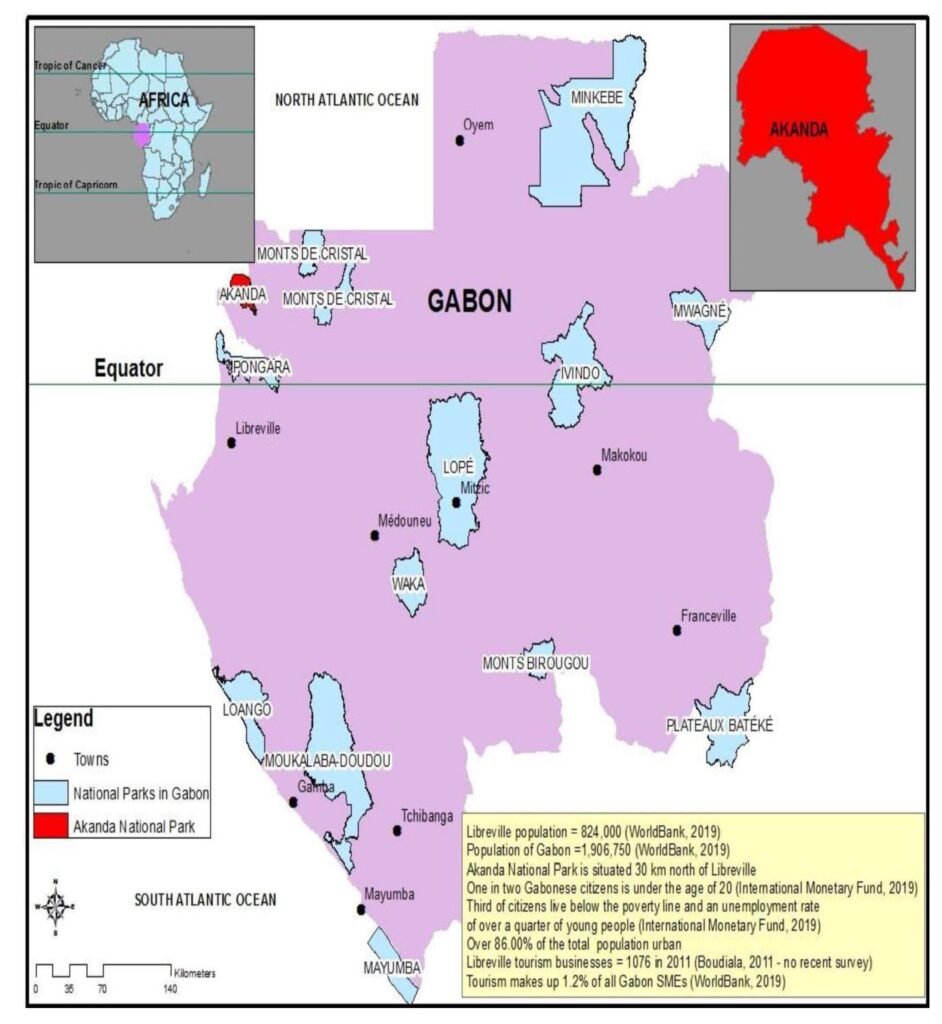
List of Gabon National Parks:
| Name | Area |
| Akanda National Park | 540 km2 (210 sq mi) |
| Batéké Plateau National Park | 2,034 km2 (785 sq mi) |
| Birougou National Park | 690 km2 (270 sq mi) |
| Crystal Mountains National Park | 1,200 km2 (460 sq mi) |
| Ivindo National Park | 3,000 km2 (1,200 sq mi) |
| Loango National Park | 1,550 km2 (600 sq mi) |
| Lopé National Park | 4,910 km2 (1,900 sq mi) |
| Mayumba National Park | 870 km2 (340 sq mi) |
| Minkébé National Park | 7,570 km2 (2,920 sq mi) |
| Moukalaba-Doudou National Park | 4,500 km2 (1,700 sq mi) |
| Mwangné National Park | 1,160 km2 (450 sq mi) |
| Pongara National Park | 929 km2 (359 sq mi) |
| Waka National Park | 1,060 km2 (410 sq mi) |
Akanda National Park
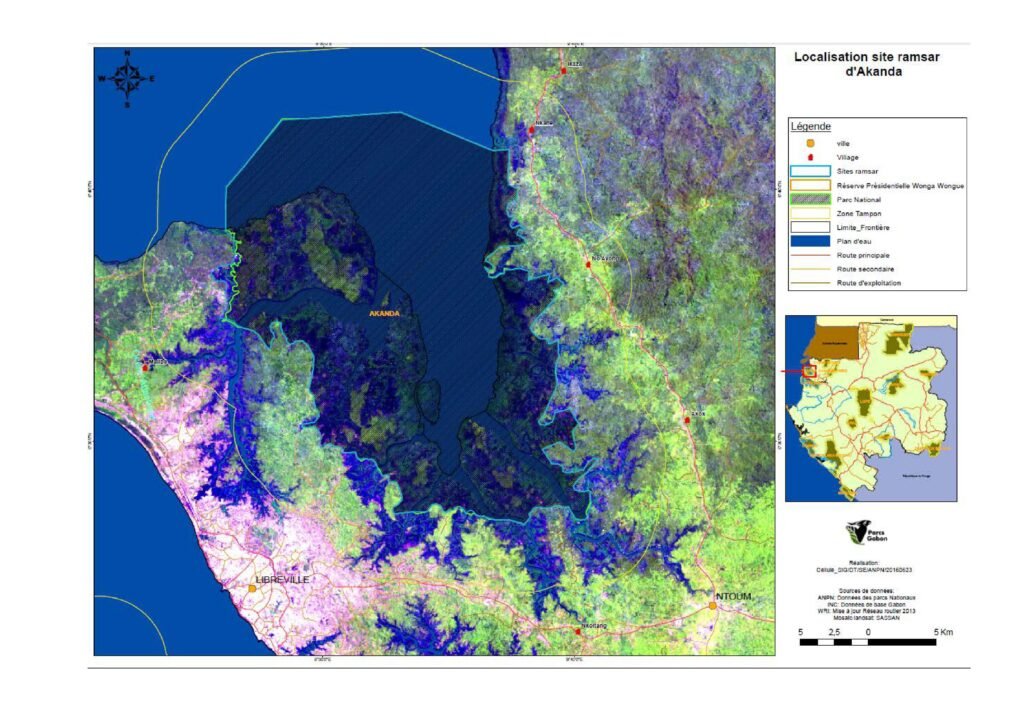
Nestled just a stone’s throw away from Libreville, the vibrant Akanda National Park beckons travelers with its ecological wonders and diverse habitats. Picture this: 35,000 hectares of untouched marine mangroves, swampy forests, and sprawling savannas, creating a haven for migratory birds and boasting a feeding ground for endangered marine turtles.
Situated along the Mondah and Corisco bays, Akanda National Park offers a haven for diverse wildlife, including migratory birds, juvenile fish, and nesting green turtles. This easily accessible gem, just a day trip from Libreville, encompasses 35,000 hectares of pristine mangroves, swampy forests, and sprawling savannas, creating a haven for migratory birds and boasting a feeding ground for endangered marine turtles. Below, we provide some insights for avid explorers:
Birdwatcher’s Paradise: Akanda hosts 35,000 to 40,000 Palearctic waders, including the charming little stint and the elegant grey plover. The endemic yellow-breasted apalis and swamp boubou find solace in this rich ecosystem.
Underwater Utopia: Dive into the marine wonderland of Akanda, a major habitat for crustaceans and fish, featuring bonga shad and flathead mullet. Despite hosting a mere 2.5% of Africa’s mangrove swamps, Gabon’s Akanda and Pongara National Park stand as towering guardians of the continent’s coastal ecosystems, safeguarding a remarkable 25% of protected mangroves.
Local Culture Integration: The Fang, Benga, and Sekiani communities thrive on the park’s resources, benefiting from fishing, agriculture, and tourism. Their cultural tapestry intertwines with the park’s ecological significance.
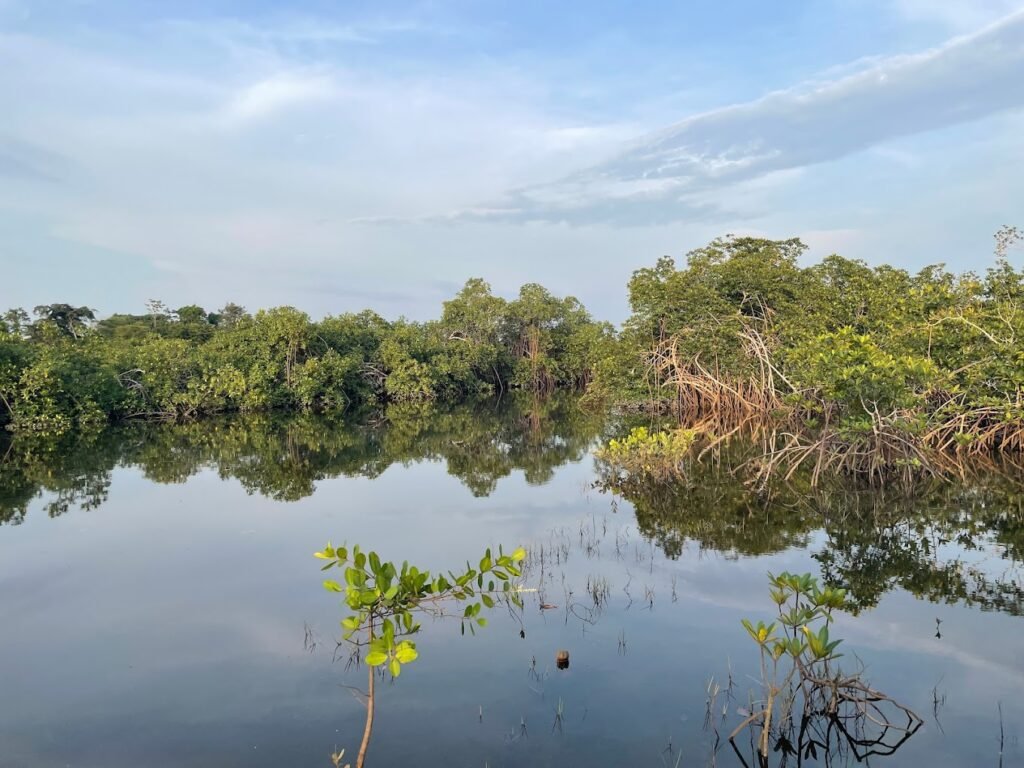
Environmental Education Hub: Proximity to Libreville positions Akanda as a leading force in environmental education. As a Ramsar Convention Wetland of International Importance, the park showcases Gabon’s commitment to biodiversity.
Conservation Challenges: However, the park faces threats from over-exploitation of mangroves, over-fishing, uncontrolled tourism, and urbanization. The ongoing development of a management plan holds promise in addressing these challenges.
The poaching of bushmeat and ivory by individuals from both neighboring countries and local communities poses a serious threat to the park’s animal populations. This illegal activity has caused long-lasting damage to the numbers of various species, jeopardizing the delicate balance of the ecosystem.
Gateway to Gabon’s Biodiversity: Established in 2002 as part of Gabon’s initiative to showcase its biodiversity, Akanda is a gem in the country’s crown, representing the unique mangrove ecosystems that play a pivotal role in stabilizing the coastline.
Visitor’s information: Visitors can marvel at the park’s rich biodiversity, from vibrant orchids and epiphytes to towering trees and ancient plants. Permits are readily available at the ANPN (National Parks Board) office in Libreville. Access to the park is possible via pirogue, with daily rates starting at CFA100,000.
Coordinates: 00°35’N 09°33’E
Batéké Plateau National Park

Explore the Bateke Plateau, a landscape frozen in time with vast savannas and weathered cliffs. This one-of-a-kind savanna is a sanctuary for exclusive wildlife and a hidden gem in the wind.
Spot the agile Angola batis, a tiny acrobat in the golden grass, or listen to the call of the Congo moor chat, its melody echoing through the secluded land. If you’re lucky, catch a glimpse of the elusive Finsch’s francolin, a jewel-toned ground-dweller exclusive to this area.
But this haven is at risk. Recent activities like deforestation and mining threaten iconic species like elephants, buffaloes, and rhinos, casting doubt on their future.
Yet, there’s hope. The Rainforest Trust and Gabon’s National Parks Agency propose an expansion to double the park’s size, securing this unique wilderness.
Imagine a future where the savanna remains untouched—a sanctuary for gorillas and forest buffaloes. Imagine butterflies flitting through vibrant riverine corridors and sunlight dappling the rainforest’s emerald embrace. This is the real potential of Bateke, a vision that needs urgent action.
Important Information: Batéké Plateau National Park
- Permits and Guidance: Obtain permits in Franceville, with the Conservation Officer guiding you to the cirques.
- Accommodations: No lodging is available within the park; Léconi provides a welcoming option. Camping under the Bateke sky is for the adventurous.
- Transportation: Public transport is limited, so a 4WD vehicle is essential to navigate the plateau.
- Animals Likely to Spot on Bateke Plateau: Angola Batis, Congo Moor-Chat, Finsch’s Francolin, elephants, buffaloes, and rhinos.
- Coordinates: 2.188°S 14.02°
Your visit is an opportunity to make a difference. Be a voice for the wildlife, and let the Bateke’s survival be the priority.
Birougou National Park
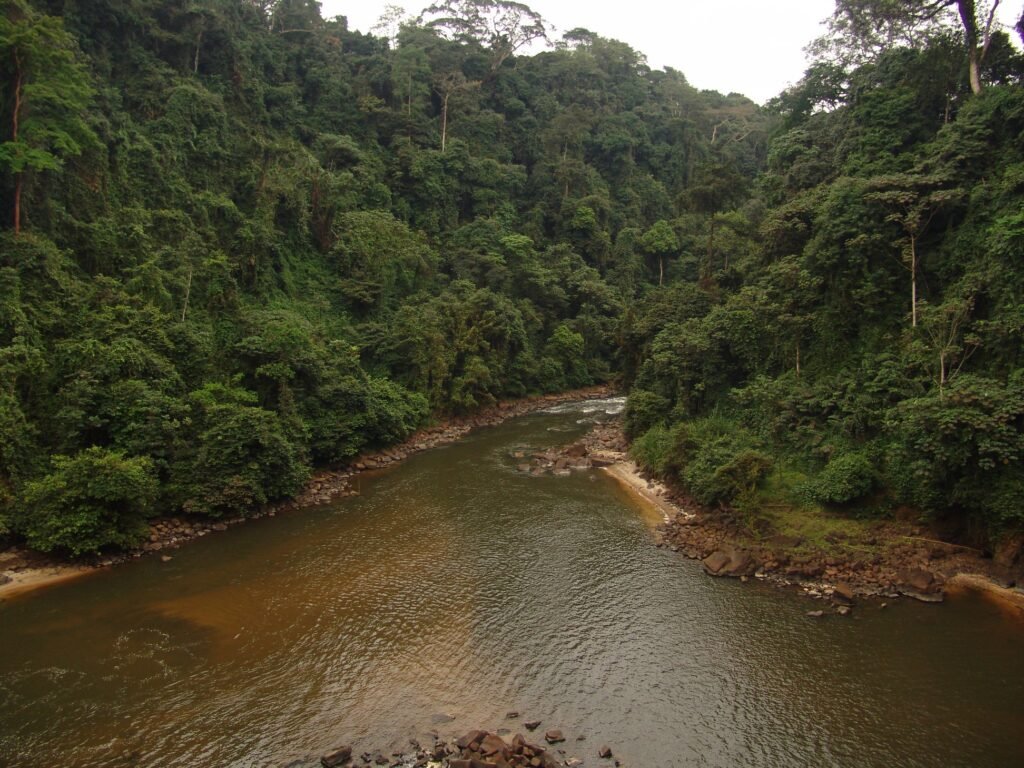
Birougou National Park is a 690-square-kilometer expanse of dense rainforest in the Chaillu Massif, central Gabon. It’s a “Pleistocene refuge,” meaning its ancient savannas, forests, and caves date back at least 40,000 years. This park is a haven for biodiversity, with primates like the critically endangered western lowland gorilla, chimpanzees, and the park’s namesake, the sun-tailed monkey, discovered here in 1988.
There are plenty of adventurous activities to indulge in when visiting this national park. Hike through valleys, swamps, and savannahs, marvel at waterfalls cascading into white-water rapids, and explore caves that whisper stories of the past. Mount Birougou, one of Gabon’s highest peaks at 975 meters, presides over this dramatic landscape.
The park’s rivers, including the Nyanga and Ngounié, are lifelines for Gabon. Protecting this ecosystem ensures clean water for communities and nourishes the park’s incredible plant and animal life.
Essential information for visitors:
- Getting there: Buckle up for an adventure! Reach Birougou by 4WD from Mbigou or Pana, or take the train to Lastoursville and hop on a minibus or “clando” (shared taxi) to Popa.
- Coordinates: 01°58’S 12°16’E
- Permits: Before embarking on your Birougou escapade, grab a permit from the ANPN office in Mbigou.
- Be prepared: While basic infrastructure is still under development, pack your sense of adventure and be ready to immerse yourself in raw, untouched nature.
- A glimpse into the future: Birougou’s unique blend of cultural and natural significance earned it a spot on UNESCO’s World Heritage Tentative List. This park is not just a wilderness; it’s a promise for the future of Gabon’s ecological and cultural treasures.
- Activities: Hiking (Mount Birougou, one of Gabon’s highest peaks at 975 meters), water rafting, and exploring caves.
Remember: Birougou is a fragile gem. Tread lightly, respect the wildlife, and leave only footprints. Let’s all be responsible visitors and help conserve this irreplaceable Pleistocene refuge.
Birougou National Park is a place where time slows down, nature reigns supreme, and every step feels like a journey into the heart of Africa’s primeval past. So, pack your bags, grab your permit, and get ready for an unforgettable adventure in Birougou!
Note: Due to its remote location and lack of infrastructure, Birougou is not for the faint of heart. But for those who crave an authentic Gabonese wilderness experience, it’s an unparalleled gem.
Crystals Mountains National Park (Parc National des Monts de Cristal)

Imagine stepping through a portal into a world where emerald rainforests shimmer under a veil of mist and rare, exotic plants unfurl like living tapestries. This is Crystal Mountains National Park in Gabon, a nature lover’s paradise so wild and untouched, it feels like stepping onto another planet.
But this isn’t just any park; it’s a two-for-one deal, with Mbe National Park and Mont Seni National Park joining forces to protect over 1,200 square kilometers of pristine wilderness. And pristine it is. Crystal Mountains boasts one of the most staggering collections of flora in Africa, with an estimated 3,000 plant species, 100 of which exist nowhere else on Earth.
Picture orchids and begonias dripping with dew, thriving in the near-constant mist, their vibrant hues contrasting with the stoic beauty of the towering Aucoumea klaineana trees. Then there’s the Bikinia, a genus of plants found only in these mystical mountains, adding to the park’s otherworldly charm.
Crystal Mountains is a wildlife wonderland teeming with creatures as rare and captivating as the plants. Western lowland gorillas lumber through the dense undergrowth, while mischievous chimpanzees swing through the canopy, their laughter echoing through the ancient trees. Forest elephants trumpet their presence, and if you’re lucky, you might catch a glimpse of the elusive mandrill or leopard, their sleek forms blending into the dappled sunlight.
And let’s not forget the monkeys! These acrobatic troupes fling themselves through the air; their playful chatter is a constant soundtrack to your adventure. Keep your eyes peeled for hundreds of butterfly species flitting by, some as rare as the euphaedra brevis, its wings a canvas of iridescent blues and greens.
For the intrepid explorer, the Crystal Mountains offers endless trails to conquer, each bend revealing a new wonder. Hike through the misty embrace of the forest, following the tracks of animals and listening to the symphony of birdsong. Then, hop on a boat and navigate across the river to reach the Mont Seni section, a wilder, less-explored part of the park. Here, you’ll find inselbergs, fascinating rock outcrops that rise like granite guardians, harboring unique plant communities adapted to their rocky perch.
Coordinates: 0.805°N 10.16°E
Important information:
- The southern section, Mbe, is easily accessible from Libreville, while Mont Seni requires a boat trip from Cocobeach.
- Permits are needed and can be obtained from the ANPN office in Kinguélé.
- Be aware of low human impact but potential threats like gold mining and hunting.
Animals you might spot:
- Western lowland gorilla
- Mandrill
- Chimpanzee
- Forest elephant
- Buffalo
- Leopard
- Monkeys
- Hundreds of butterfly species
Activities:
- Hiking
- Boat trips
- Wildlife watching
- Birdwatching
- Plant identification
Ivindo National Park
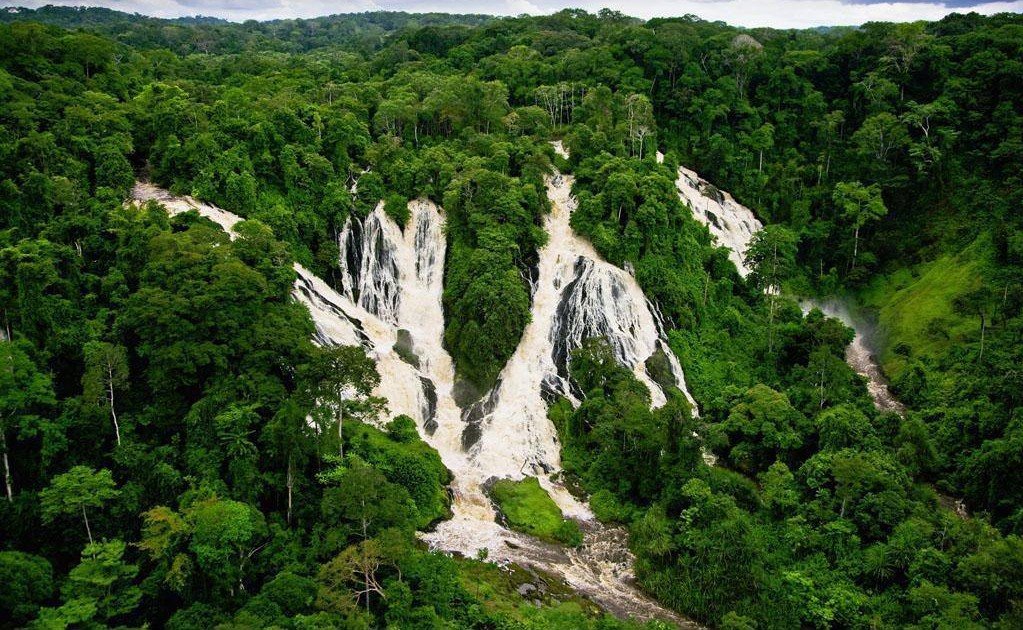
Deep in the verdant heart of Gabon, where the equator cuts a swathe through dense rainforest, lies Ivindo National Park, a staggering 300,000 hectares of pristine wilderness. Imagine blackwater rivers snaking through the jungle like inky ribbons, their rapids and waterfalls whispering secrets to the moss-draped trees. This is a landscape where nature reigns supreme, an untouched Eden teeming with life. Owing to its diverse and rich biodiversity and its untouched tropical forest, the park was designated a UNESCO World Heritage Site in 2021.
Its crystal-clear waters inhabit a variety of fish, 13 of them teetering on the brink of extinction. Podostemaceae riverweeds, delicate as spun glass, cling to rocks in a kaleidoscope of colors. And hidden beneath the surface lurks the Critically Endangered Slender-snouted Crocodile, a survivor from a time before time.
As you tiptoe through the cathedral-like silence of the old-growth forest, keep your eyes peeled for the giants. Western lowland gorillas crash through the undergrowth, their silverbacks shimmering like ghosts. Chimpanzees swing through the canopy, their hoots echoing through the ancient trees. Forest elephants, some of the last of their kind, trumpet greetings to each other, their tusks like polished ivory daggers. And don’t forget the mischievous monkeys, a technicolor circus swinging from vine to vine.
Listen for the raucous calls of red river hogs and the bugle of the elusive sitatunga, a semi-aquatic antelope that blends into the swamp like a living shadow. Look up to catch a flash of the endangered grey-necked rockfowl, a prehistoric-looking bird with piercing eyes. And when dusk paints the sky in hues of orange and purple, listen for the haunting cry of the grey parrot, a feathered emerald guarding secrets in its beak.
Additionally, the park abounds with 430 bird species that flit through the branches, butterflies with wings like stained glass windows dance on the breeze, and countless insects hum their silent symphony. But what you can’t miss are the spectacular Kongou and Mingouli waterfalls. Towering over 60 meters, Kongou waterfalls are among the highest falls in equatorial Africa.
Other key features of Ivindo National Park are the Ipassa Makokou Biosphere Reserve and Langoué Baï, which are touted for being one of the 5 most important clearings in Central Africa.
Ivindo River, the lifeblood of the park, winds its way through lush forests and towering mountains like Kingué (749m) and Ngouadi (870m). Rainfall is plentiful, peaking in September–December and February–May, with occasional violent storms that bring localized tornadoes, especially on the Ipassa Plateau. These storms may contribute to the forest’s resemblance to a secondary forest. With an average temperature of 23.9°C and seasonal variations of around 3.3°C, the park offers a pleasant climate year-round.
Feeling the call of the wild? Pack your sense of wonder and head to Langoué Baï, a mineral-rich clearing that acts as a magnet for forest royalty. Here, you can watch elephants lumbering from the trees, gorillas grazing peacefully in the dappled sunlight, and buffaloes wallowing in the mud like contented hippos. It’s a scene straight out of a National Geographic documentary, but you’re not watching from afar – you’re right in the thick of it.
Here are some important tips for visitors:
- Permits are required: You can get them from the ANPN office in Makokou.
- Best time to visit: The dry season (June-September) offers the most comfortable conditions, but wildlife viewing is good year-round.
- Respect the wildlife: Keep your distance, avoid using flash photography, and never feed the animals.
- Pack for the elements: Rain gear, sturdy boots, long sleeves, and insect repellent are essential.
- Leave no trace: Pack out everything you bring in, and dispose of waste responsibly.
Coordinates: 0.088°N 12.63°E
Animals you might see:
- Western lowland gorilla
- Chimpanzee
- Forest elephant
- African forest buffalo
- Red river hog
- Sitatunga
- African golden cat
- Slender-snouted crocodile
- Grey-necked rockfowl
- Grey parrot
Key Features: Incredible Kongou and Mingouli waterfalls; rich wildlife; the Ipassa Makokou Biosphere Reserve and Langoué Baï, and the Ivindo River.
Average Temperature: 23.9°C
Loango National Park
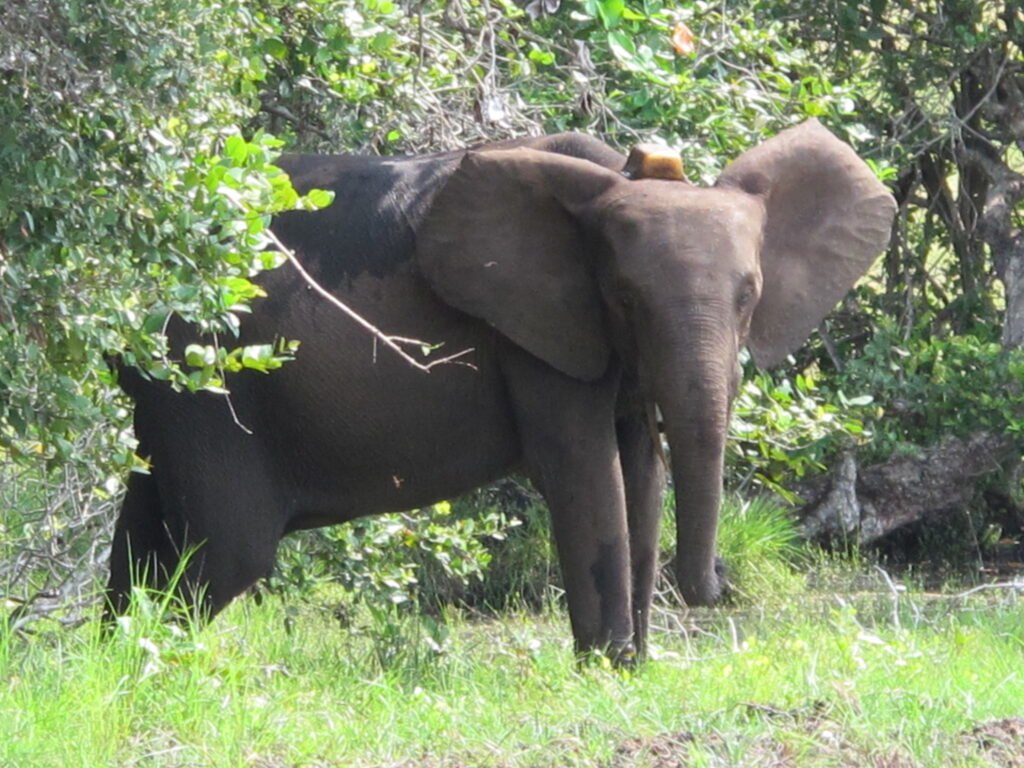
Another must-see nature attraction in Gabon is hands-down Loango National Park, an untouched gem on the west coast where nature’s wonders intertwine in breathtaking harmony. Visitors can expect to find crystal-clear streams cascading through verdant forests and their waters merging with the vast expanse of the savannah. Imagine vast lagoons dotted with islands, their shores stretching into miles of pristine white sand, beckoning visitors to explore their uncharted depths.
Loango is a blissful haven where the Big Five roam freely, not just confined to the savanna’s expanse. These majestic creatures, from hippos catching waves with playful abandon to elephants basking under the sun and gorillas strolling gracefully along the shore, create a wildlife spectacle that rivals any documentary.
The marine life here is equally mesmerizing. Gabon, after South Africa, boasts the second-richest concentration of whales and dolphins on the planet. Humpback whales and orcas perform breathtaking acrobatics just offshore, their graceful movements rivaling the best shows at SeaWorld. With over 100 kilometers of unspoiled coastline, Loango offers secluded coves and endless opportunities to encounter these marine marvels.
Loango’s allure extends beyond the iconic wildlife. Shy sitatungas wade through the swamps, their presence barely discernible amidst the lush greenery. Nimble red duikers dart through the undergrowth, their movements a fleeting glimpse of nature’s agility. And the turquoise-banded kingfisher, a local celebrity, streaks across the water’s surface, its vibrant plumage catching the sunlight.
For birdwatchers, Loango is a paradise. Over 400 species flit through the trees, their songs echoing through the air. The Loango weaver, a rare and captivating bird, adds a touch of exclusivity to this avian haven.
Coordinates: 2°10′S 9°34′E
Visiting Loango: Your wildlife adventure checklist
- Catch a wave with the surfing hippos: Witness these gentle giants frolicking in the surf—a sight that will have you saying, “Did that just happen?”
- Trek through gorilla paradise: Embark on a guided forest walk and come face-to-face with western lowland gorillas, the gentle giants of the jungle.
- Kayak with playful dolphins: Glide alongside pods of acrobatic dolphins, their whistles and splashes filling the air.
- Whale watching, anyone? Witness the sheer majesty of humpbacks and orcas breaching just offshore, a memory etched forever.
- Explore hidden coves and secret beaches: Find your slice of paradise on miles of pristine coastline, perfect for beachcombing or simply soaking up the sun.
Animals galore:
- Western lowland gorillas
- Forest elephants
- Buffaloes
- Hippos (the surfing kind!)
- Leopards
- Sitatungas
- Red duikers
- Dolphins (including playful humpback dolphins)
- Humpback whales
- Orcas
- Over 400 bird species, including the rare Loango weaver
Lopé National Park
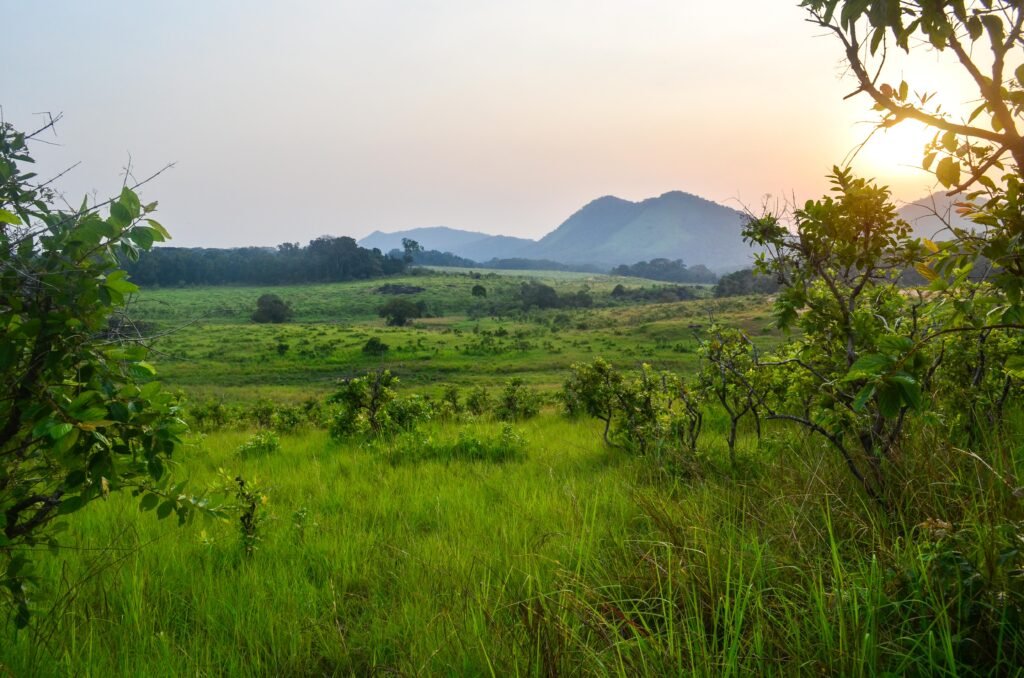
Nestled in the heart of Gabon, La Lopé National Park is a mesmerizing tapestry of lush rainforests, sprawling savannas, and the meandering Ogooué River. This UNESCO World Heritage Site, spanning an impressive 4913 square kilometers, is a haven for a diverse array of wildlife, including the critically endangered mandrill, the majestic western gorilla, and the elusive giant pangolin.
Its vast terrain has been sculpted over millions of years and gently elevated from 300 to 350 meters above sea level, culminating in the awe-inspiring Mont Brazza, which gracefully ascends to over 900 meters in the south. In the north, a mesmerizing geological phenomenon unfolds: the riverbed of the Ogooué River gracefully dips, creating a captivating dance as it flows for an astounding 100 kilometers. The river’s energetic journey sculpts the land into mesmerizing river terraces, adding to the park’s scenic grandeur.
Villages like Lopé-Boléko and Ayem nestle harmoniously within the park’s embrace, their inhabitants living in sync with the surrounding wilderness. Lopé-Boléko pulsates with life, its 600 residents spread over 621 hectares. Ayem, with its 300 inhabitants nestled within 71 hectares, adds its unique charm to the park’s vibrant mosaic. Other settlements, from Kazambabika to Ramba, each whisper their own stories, some bustling with life, while others exude a tranquil serenity.
Visitor Information
- Permits: Permits are required to enter La Lopé National Park. Contact the ANPN office in Lopé for details.
- Accommodation: The park offers a range of accommodation options, from chalets to campsites.
- Activities: Activities include wildlife watching, hiking, birdwatching, and cultural experiences.
Animals to See
- Mandrills
- Elephants
- Western lowland gorillas
- Chimpanzees
- Forest elephants
- Over 412 bird species, including rare and elusive ones
Coordinates: 0.4412° S, 11.5248° E
Mayumba National Park
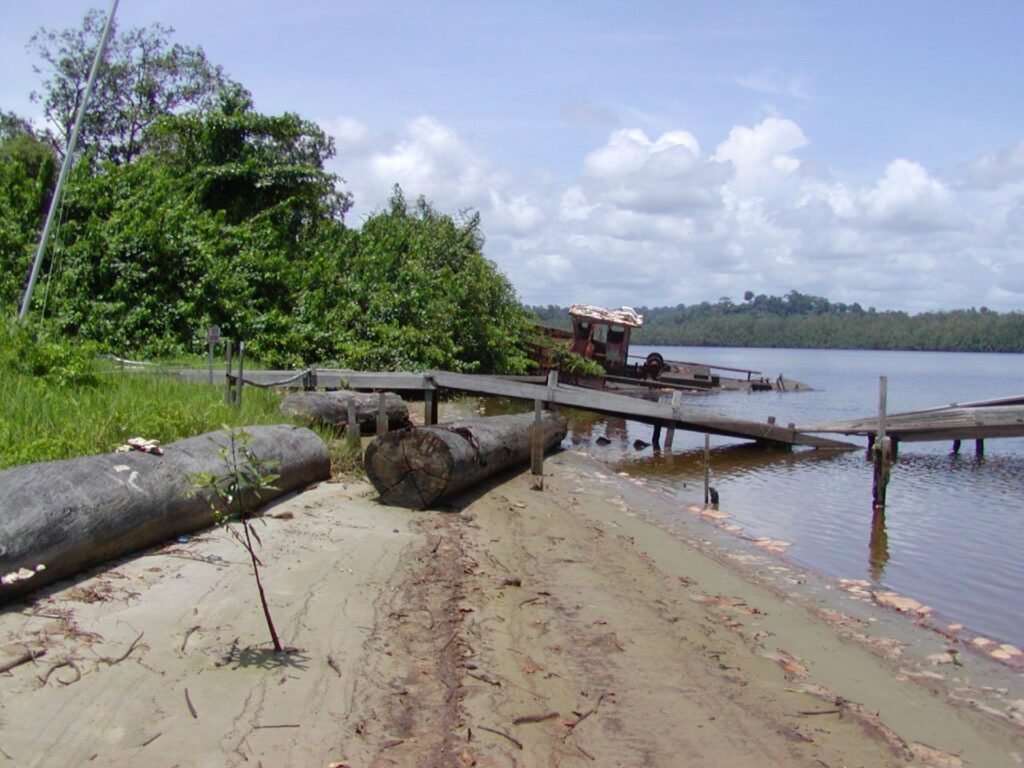
Beautifully tucked away in the southwestern corner of Gabon, Mayumba National Park is a breathtaking expanse of coastal wilderness that harbors a kaleidoscope of wildlife. From the rugged coastline to the verdant rainforest interior, this park is a haven for a remarkable array of animals.
The park’s most notable feature is its 60 kilometers of pristine beaches, which serve as nesting grounds for endangered leatherback turtles. During the nesting season, from October to February, these gentle giants haul themselves ashore to lay their eggs, providing a mesmerizing spectacle for visitors.
Venture inland and you’ll discover a diverse ecosystem teeming with life. Forest elephants, the largest land mammals on the continent, roam freely; their massive figures are a testament to the park’s pristine habitat. Their fellow pachyderms, the African buffalo, also call Mayumba home, their imposing presence adding to the park’s wilderness allure.
The rainforest canopy is abuzz with activity as monkeys of all shapes and sizes swing through the trees. Black and white Colobus monkeys, their striking plumage a contrast to the lush greenery, are a common sight, while agile Diana monkeys leap from branch to branch with effortless grace.
But the park’s wonders extend beyond its terrestrial inhabitants. In the turquoise waters off the coast, dolphins and humpback whales perform acrobatic leaps and dives, their majestic presence captivating visitors. Manta rays, with their graceful elegance, glide through the depths, their vast wingspans creating an unforgettable sight.
For those seeking a truly immersive wildlife experience, Mayumba National Park offers a variety of guided tours and excursions. Experienced guides will lead you through the park’s hidden corners, revealing the secrets of its rich biodiversity.
Here’s a list of animals you might encounter in Mayumba National Park:
- Leatherback turtles: These gentle giants are the largest turtles in the world, weighing up to 600 kilograms. They migrate thousands of kilometers to lay their eggs on Mayumba’s beaches. Leatherback turtles in Mayumba National Park
- Forest elephants: These majestic mammals are the largest land animals on the continent. They roam freely in Mayumba’s forests, feeding on a variety of vegetation.
- African buffalo: These powerful bovines are known for their aggressive temperament. They are a common sight in Mayumba’s savannas.
- Black and white Colobus monkeys: These monkeys are characterized by their black bodies and white faces and hands. They are active members of Mayumba’s rainforest ecosystem.
- Diana monkeys: These agile primates are known for their reddish-brown fur and distinctive black face markings. They are often seen leaping from branch to branch in Mayumba’s forests.
- Dolphins: Dolphins are a common sight in Mayumba’s coastal waters. They perform acrobatic leaps and dives, delighting visitors with their playful antics.
- Humpback whales: These majestic creatures migrate to Mayumba’s waters during the winter months to breed and give birth. Their haunting songs can be heard echoing through the air.
- Manta rays: These gentle giants are the largest rays in the world. They are often seen gliding through Mayumba’s waters, their vast wingspans creating an awe-inspiring spectacle.
Tips for Visitors:
- The park is best explored during the dry season, from May to November.
- Be prepared for hot and humid weather, especially in the rainforest.
- Wear insect repellent to ward off mosquitoes and other biting insects.
- Bring plenty of water and snacks, as food and drinks are limited within the park.
- Respect the park’s wildlife and do not disturb any animals.
- Leave no trace of your visit, and dispose of all waste properly.
- Hire a guide to ensure a safe and enjoyable experience.
Things to Do in Mayumba National Park
- Hike through the rainforest and spot wildlife, including forest elephants, antelopes, and chimpanzees.
- Explore the mangrove forests and witness the diversity of marine life, including dolphins, manta rays, and sharks.
- Visit the nesting beaches of leatherback turtles and observe their remarkable journey to the sea.
- Join a guided tour to learn about the park’s flora and fauna from experienced ranger guides.
- Visit the local village to experience the rich culture and traditions of the Gabonese people.
Coordinates: 3.8195° S, 11.0203° E
Minkébé National Park – The Largest National Park of Gabon
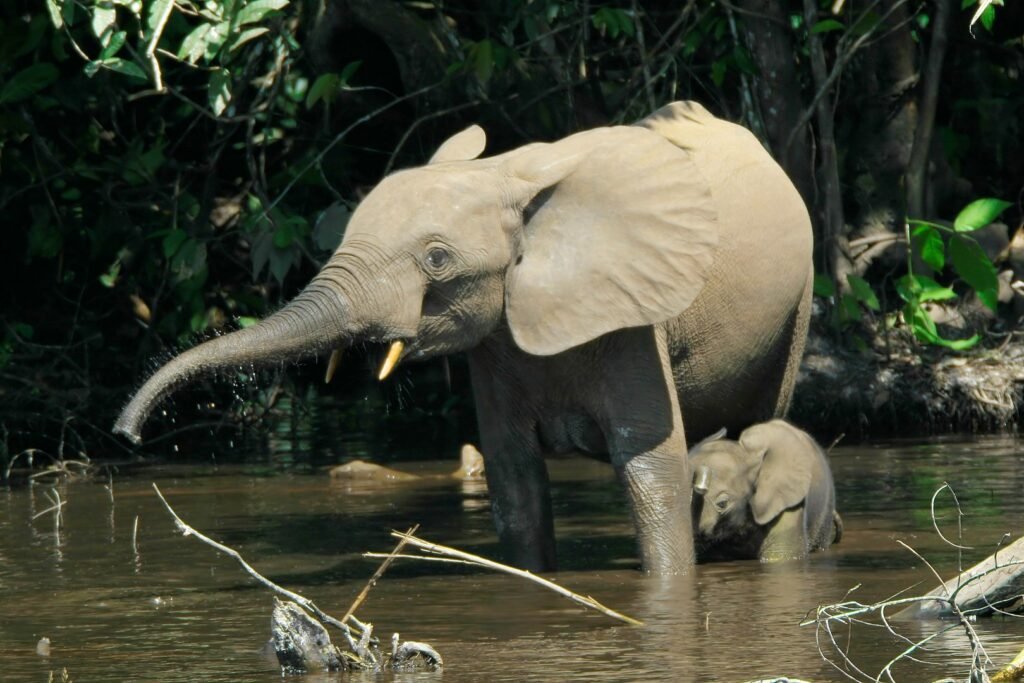
Located in the northeastern corner of Gabon, Minkébé National Park sprawls over an impressive 7,570 square kilometers, making it the largest among Gabon’s parks. This vast wilderness serves as a crucial haven for the Congo Basin’s elephants, boasting a staggering population of around 30,000 individuals. But Minkébé isn’t just an elephant sanctuary; it’s a thriving ecosystem teeming with a diverse array of wildlife. Gorillas, forest buffaloes, and elusive sitatungas roam freely, sharing the dense forest with antelopes, including the endangered bongo, leopards, pythons, and pangolins. Inselbergs, ancient rocky formations, pierce the forest canopy, adding a unique geological dimension to the landscape. Towering trees and a myriad of plant life, from orchids to ferns, contribute to the park’s rich biodiversity.
As you embark on your adventure, keep an eye out for the following highlights:
Key Points for Visitors:
- Secure permits at the ANPN office in Makokou before venturing into the park.
- Marvel at the ancient inselbergs that rise above the lush forest.
- Keep an eye out for the diverse array of wildlife, including elephants, gorillas, and rare antelopes.
- Immerse yourself in the unique flora, from towering trees to delicate orchids.
Animals to Spot:
- Forest elephants (one of the largest populations in Africa)
- Gorillas
- Forest buffaloes
- Sitatungas
- Endangered bongo antelopes
- Leopards
- Pythons
- Pangolins
- Red river hogs
- Mandrills
- Black colobus
- Chimpanzees
- Golden pottos
- Dwarf crocodiles
- Spotted-necked otters
- Crested mangabeys
- Water chevrotains
- Rare Gabonese species: bongo and giant forest hog
Coordinates: 1°40′47.18″N 12°45′34.21″E
However, amidst this natural wonder, challenges loom. The park faces threats such as logging of Gabonese redwood trees, low-scale gold mining, and hunting. Logging concessions and the potential for iron ore mining near the park could jeopardize its future. Conservation efforts led by WWF, including regional collaboration under the Dja-Odzala-Minkébé Tri-National Initiative, aim to counteract these threats. The park’s riparian areas host diverse aquatic life, while the swampy zones provide a habitat for parrots and pythons.
Not just a sanctuary for wildlife, Minkébé holds cultural significance. While the park itself remains uninhabited, nearby forests are home to Baka pygmy, Fang, Kota, and Kwèl ethnic groups, each contributing to the region’s rich cultural heritage.
Moukalaba-Doudou National Park

Drive about 600 km from Libreville and find Moukalaba-Doudou National Park, where emerald rainforests cling to misty mountains, rivers snake through golden savannas, and lakes shimmer like scattered jewels.
Trek through the dense canopy and find yourself face-to-face with a family of western gorillas, the park’s most treasured residents. With over 4,600 individuals, Moukalaba-Doudou is one of their last refuges. Listen to their guttural calls, watch their playful youngsters tumble, and be humbled by their gentle majesty.
Herds of elephants trumpet across the plains, their tusks glinting like polished daggers. Hippos wallow in muddy pools, their snorts echoing through the humid air. And keep your eyes peeled for the flash of an egret or the rare black-winged bishop, flitting among the reeds.
Planning your Moukalaba-Doudou adventure?
- Permits: Grab yours at the ANPN office in Tchibanga.
- Access: The south and east are reachable from Tchibanga, but for the west, you’ll need a boat from Gamba.
- Respectful encounters: Maintain a safe distance from wildlife and follow park regulations.
Wildlife likely to spot:
- Western lowland gorillas
- Chimpanzees
- Forest elephants
- Hippos
- Waterbucks
- Egrets
- Black-winged bishops
Beyond the checklist:
- Community: Learn how local villagers are finding harmony with wildlife through conservation projects.
- Research: Peek into the fascinating world of gorilla habituation, where scientists are learning the secrets of these gentle giants.
- Ecotourism: Be part of the solution by supporting responsible tourism that benefits both people and nature.
Coordinates: 2°26′S 10°25′E
Mwangné National Park

Deep within the heart of Gabon, nestled along the border with the Republic of Congo, lies Mwagna National Park. This beautiful wilderness, stretching over an expanse of 1,160 square kilometers, is an untamed realm of emerald forests, towering giants of the tree kingdom, and a mesmerizing tapestry of life.
As you venture into this verdant haven, prepare to be greeted by the echoing trumpets of forest elephants, their ivory tusks gleaming like polished ebony, their presence a testament to the park’s unspoiled grandeur. Let your gaze soar through the canopy, where nimble primates swing with ease, their playful chatter intermingling with the symphony of nature.
Bongo antelopes, their sleek bodies adorned with striking black and white stripes, blend seamlessly with the dappled sunlight dappling the forest floor. Their serene grazing provides a moment of tranquility amidst the vibrant energy of the park.
But amidst this enchanting realm, a touch of mystery lingers. The Gabon viper, a jeweled emerald with a venomous bite and an air of regal authority, basks lazily beside a tranquil pool, where Hartlaub’s ducks glide gracefully.
And then, a sudden rustle in the undergrowth sends a shiver down your spine – could it be the elusive mokélé-mbembé, a dinosaur-like creature whispered about in Pygmy folklore? Some say it’s a relic of ancient times, a behemoth lurking in the depths of the forest, its existence shrouded in enigma.
Whether you catch a glimpse of this legendary beast or not, Mwagna National Park promises an unforgettable adventure. With its vibrant wildlife, pristine beauty, and hint of mystery, it’s a place where nature’s wonders unfold in all their splendor. So, pack your backpack, sharpen your senses, and embark on a journey to this untamed paradise.
Here’s your Mwagna must-know:
- Getting here: Buckle up for an adventure! Take the road from Makokou to Mékambo, then brace yourself for a 14-kilometer nature walk. No roads, just you and the wild.
- Park Permit: ANPN office, phone number: +241 07 80 09 40
- List of animals:
- Forest elephants
- Western lowland gorillas
- Bongos
- Forest hogs
- Primates galore
Coordinates: 0°36′N 12°42′E
Pongara National Park
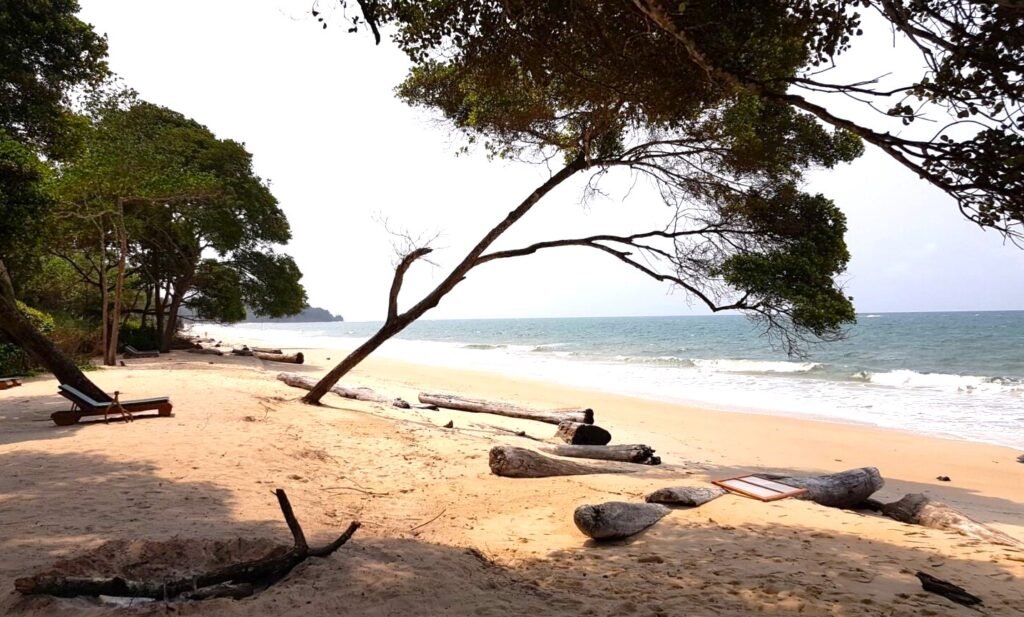
Forget the honking horns and traffic lights; Pongara National Park is where the wild things are—and they’re laying eggs on the beach! This wildlife wonderland, a stone’s throw from Libreville, Gabon, is where the concrete jungle melts away and nature’s orchestra takes over.
Sure, the lodges are swanky and the beaches postcard-worthy, but it’s the animals who steal the show. From November to March, witness the primeval ritual of leatherback turtles, the largest sea turtles on Earth, lumbering ashore under a blanket of stars to lay their precious eggs. Park guides lead you to these magnificent creatures, their flippers wider than your wingspan, their prehistoric gaze fixed on a mission older than time.
But Pongara’s got more than just turtles up its sleeve. When the dry season paints the land golden (July to October), humpback whales erupt from the ocean’s surface, their songs echoing across the waves. Permits are a breeze, thanks to the helpful Conservation Officer.
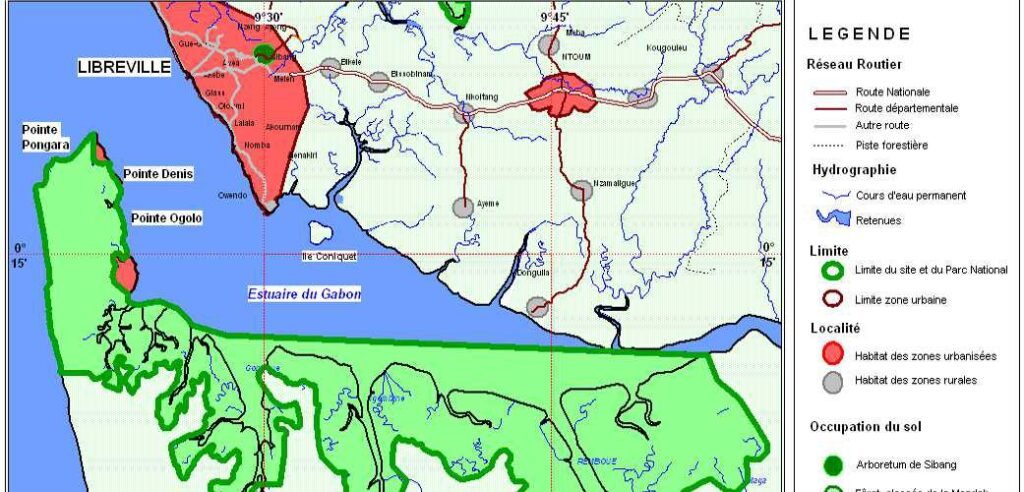
Think you’ve seen it all? Think again. Pongara’s emerald embrace hides a menagerie of creatures. Forest giants like elephants and buffaloes roam the dappled sunlight, while mischievous monkeys swing through the canopy. Red river hogs, their tusks glinting like rubies, snort through the undergrowth, and chimpanzees, our closest cousins, whisper secrets in the rustling leaves.
Feeling the wanderlust tugging at your heart? Here’s your Pongara survival guide:
- Turtle Time: November to March is your window into the leatherback ritual. Book your lodge early, as everyone wants to be part of this ancient ballet.
- Whale Whispers: From July to October, pack your ears for the haunting melodies of humpback whales. Don’t forget your camera; you’ll want proof of these ocean giants serenading you.
- Forest Fiesta: Rainy seasons (September to December and February to May) are prime time for spotting Pongara’s landlubbers: elephants, buffaloes, monkeys, and elusive duikers.
- Wildlife: Duikers, monkeys, Red river hogs, buffaloes, humpback whales, and leatherback turtles
- Coordinates: 0°07′N, 9°38′E
Waka National Park
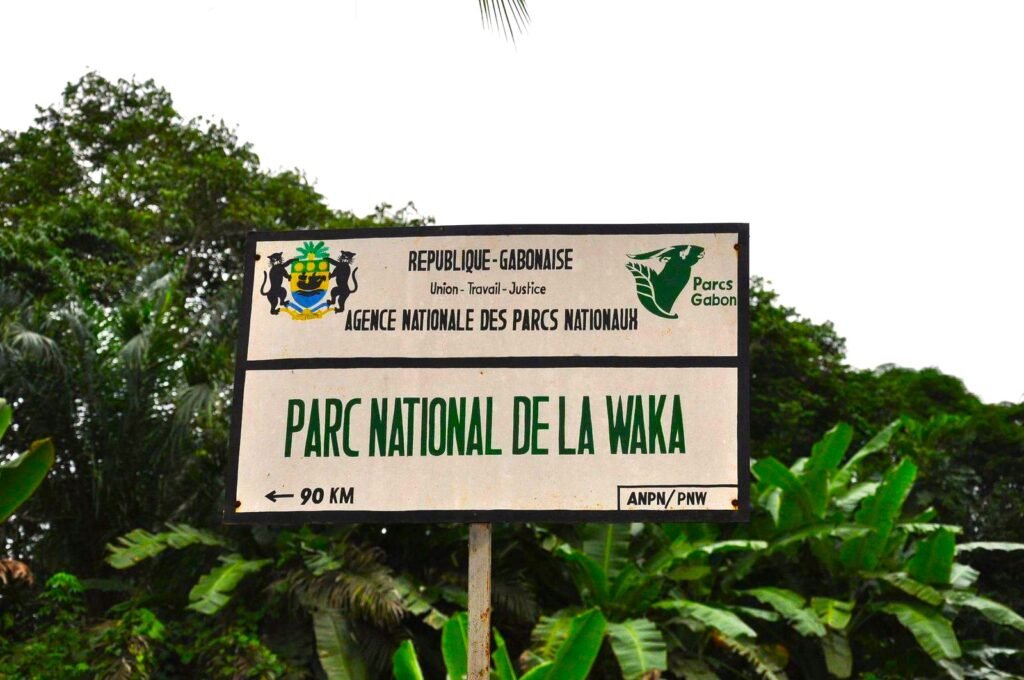
Step back 40,000 years into a primeval world where ancient savannahs whisper secrets and forests stand as silent sentinels, sheltering a Pleistocene refuge of unique life. This isn’t a fantasy; it’s Waka National Park, a Gabonese gem tucked away in the Chaillu Massif, 450km from Libreville.
Getting here is no walk in the park (literally). No fancy lodges or tourist trails pamper visitors here. This is raw, untamed Africa, accessible only by a dusty road to the village of Oghoubi, followed by a permit-armed trek to the ANPN office in Fougamou. Be prepared to be your own wilderness chef, packing everything you need for self-sufficiency.
But roughing it is a small price to pay for what awaits. Waka’s wild soul teems with ancient magic. Lush rainforests explode with life—a vibrant group of mandrills, apes, and elephants, their trumpeting calls echoing through the canopy. Look closely, and you might spot the sun-tailed guenon, a primate endemic to this lost world.
But there is a sad reality about this area. Logging and bushmeat hunting gnaw at the park’s northern borders is a constant threat to the ecological balance that sustains not just the animals but also the local people who call this land home.
- Getting There: Buckle up for a bumpy 450km journey from Libreville to Oghoubi, followed by a permit-armed trek to Fougamou’s ANPN office.
- Supplies: Pack everything you need – food, water, camping gear – you’re on your own.
- Wildlife Wonders: Seek mandrills, apes, elephants, and the sun-tailed guenon in the south.
- Respect the Refuge: Be a responsible visitor. Leave only footprints, take only memories.
Coordinates: 1°14′S 11°4′E
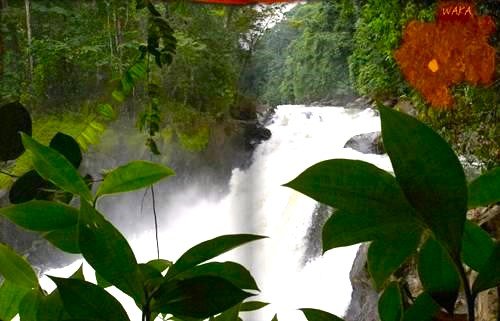
References
Van der Heijden, M.H., Van der Hoeven, J.J., & Van der Laan, M.J. (2023). A preliminary vegetation assessment of the Mbe National Park, Monts de Cristal, Gabon. ResearchGate. Retrieved December 5, 2023, from https://www.researchgate.net/publication/268218195_A_PRELIMINARY_VEGETATION_ASSESSMENT_OF_THE_MBE_NATIONAL_PARK_MONTS_DE_CRISTAL_GABON
Zanre, R., & Bester, M. N. (2011). Vagrant Subantarctic fur seal in the Mayumba National Park, Gabon [PDF]. African Zoology, 46(1), 185-187. doi:10.1080/15627020.2011.11407492
Balinga, M. P. B., Sunderland, T., Walters, G. M., & Issembe, Y. (2006). A vegetation assessment of the Waka National Park, Gabon. Central African Regional Program for the Environment (CARPE).
DOI: 10.13140/2.1.3766.4966